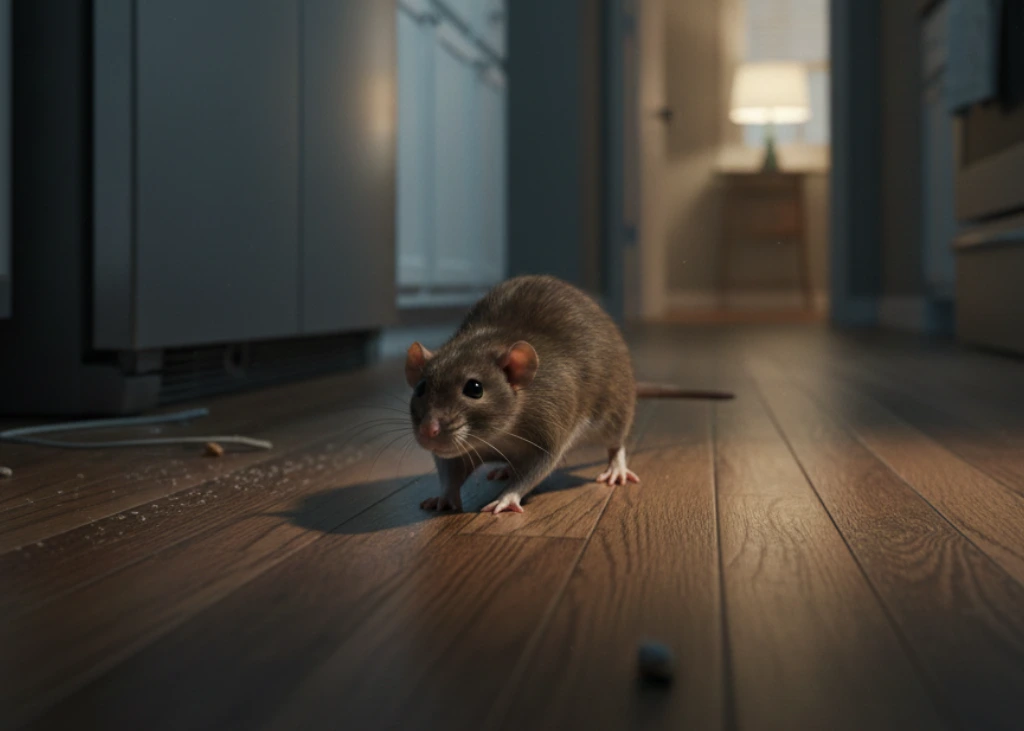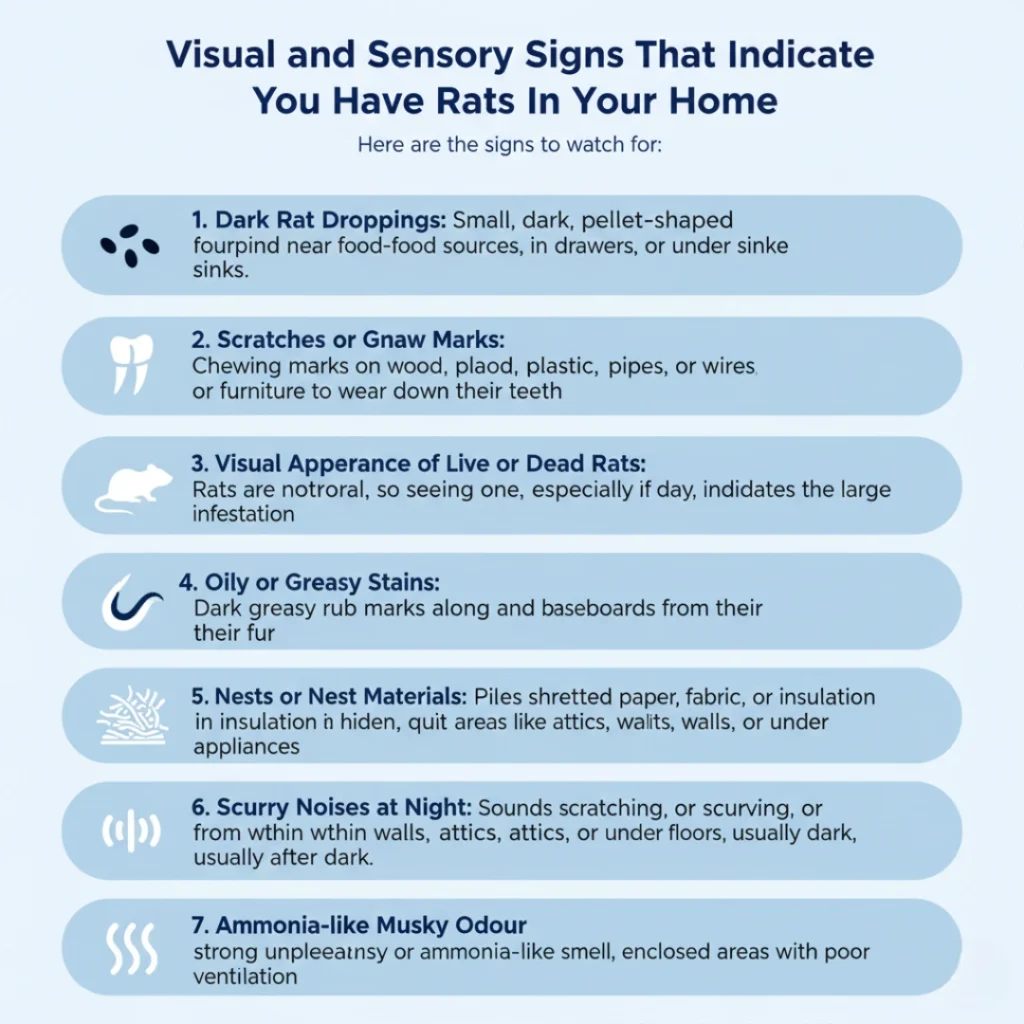Imagine hearing a scurry behind the wall at midnight. The first thought that comes to mind is—rat. If you are right then probably there are a lot more in your living space. Guessing isn’t enough to determine their numbers; you need a logical approach.
If you want to know how to tell how many rats are in your house, this article will help. We’ll walk through practical methods to estimate their population and effective ways to exterminate rats. Ready? Let’s get started.
How to tell how many rats are in your house?
Ever heard the saying that you’re never more than 6 feet from a rat? Rat problems are pretty widespread, but knowing the real numbers helps put the issue into perspective.
Rats don’t stay solo for long. They reproduce and multiply quickly. While you’re counting, their numbers are increasing even more. Rats build nests first, and eventually, they move on to establish a colony. Don’t be surprised if we say a colony can contain anywhere from a few to hundreds of rats—that’s actually true. The larger the colony, the more rats it will have. A house that’s moderately to severely infested may harbor at least a dozen rats. Some visual and sensory clues help to detect their presence.
How many rats are in a nest?
Rats are active at night and prefer to hide in nests they build themselves during the day. With continuous reproduction, the number of nests grows over time. But the question remains: how many rats can fit into one nest? That really depends.
Indoor rat nests generally hold between 5 and 15 rats. In London, this is a common range, but the actual count may vary. When an infestation becomes severe, multiple nests form, creating larger colonies. These colonies often have ongoing breeding, so their numbers keep rising. To estimate how many rats are around, you might look for droppings or sprinkle talcum powder along crawling paths to observe footprints. Keep in mind, rats breed rapidly, so their numbers can grow rapidly.
How fast do rats reproduce?
Female rats typically become sexually mature by 5 weeks old, though some might take a bit longer. After reaching maturity, they start breeding. Usually, one female can have around 5 litters per year, with each litter averaging 6 to 12 pups. While some pups might not survive, a pair of rats can produce as many as 2,000 pups in a year.
When a rat reproduces and its pups grow up, the mother and her offspring continue to produce more rats together, creating a never-ending cycle. Can you imagine it? Your house becomes overrun with these nasty rodents, turning your home into a playground for them and a living hell for you—little by little. That’s truly horrible.

Visual and sensory signs that indicate you have rats in your home
Rats reveal their presence through various visual and sensory signs. The more severe the infestation, the more prominent these signs become. Let’s explore the common indicators:
1. Dark Rat Droppings:
An adult rat typically releases 40-80 droppings per day. These droppings are often found in crawling areas or lofts. They can vary in size from rice-sized to larger, depending on the rat’s age. If you notice both small and large droppings, it suggests you have a mix of pups and adult rats—possibly indicating a breeding colony.
2. Scratches or Gnaw Marks:
Rat teeth grow continuously throughout their lives, which is why they constantly chew to keep their teeth trimmed. Rats have very strong teeth capable of gnawing through pipes, cables, wires, and even furniture. You’ll often find gnawed objects or holes, which are clear signs of their presence.
3. Visual Appearance of Live or Dead Rats:
If you have a pet cat, you might find dead rats in your home. Since rats are nocturnal, it’s uncommon to spot live ones during the day unless the infestation has gotten out of control. A daytime sighting of a live rat is a red flag that things might be worse than you think.
4. Oily or Greasy Stains:
When rats crawl around, they leave behind oily, greasy rub marks on walls or baseboards. Spotting these sticky stains is a strong indication of rat activity inside your home.
5. Nests or Nest Materials:
Rats tend to make nests in the loft or near places they crawl. Keep an eye out for nests or leftover nesting materials hiding in dark corners.
6. Scurry Noises at Night:
Late-night scratching or scurrying sounds usually mean rats are nearby. The louder the sounds, the higher the rat population.
7. Ammonia-like Musky Odour:
A stale, ammonia-like smell from rat urine is a telltale sign. If you detect this scent, investigate your home for nests.

How to get rid of rats?
Eradicating rats involves several step-by-step procedures. Here’s how to get rid of rats:
■ Cut Off Food and Water Supplies: Keep leftovers covered, wash dishes promptly, and bring pet food inside at night. Remove pet water bowls and ensure trash is sealed tightly, as rats often scavenge through garbage.
■ Block Entry Points and Declutter: Seal all holes or cracks 5mm or larger with steel wool or metal mesh. Remove clutter and debris to eliminate hiding spots and nesting sites.
■ Apply Repellents: Natural repellents like peppermint oil can help deter rats, but in severe cases, they might not be enough.
■ Trap and Bait: Set live traps or snap traps to catch rats. Bait stations with rodenticides are also effective for extermination.
■ Seek Professional Help: Pest control specialists can thoroughly inspect, identify causes, and remove rats using professional-grade poisons. For larger infestations, don’t hesitate to hire residential pest control professionals.
How to know if all the Rats are gone?
How can you be 100% sure that all of them are gone? Here are the signs that confirm rats are no longer present:
- Noise-free nights: You might suddenly notice that you’re no longer hearing the irritating chaos of rats—no scurrying or scratching sounds at all.
- No droppings or urine smells: When rats are gone, there will be no more droppings or ammonia-like odors. That’s such a relief, isn’t it?
- Absence of chewed materials or gnaw marks: No rats means no gnawed materials or marks. Your furniture and walls are safe from gnawed holes.
- No shredded paper or rat presence: There shouldn’t be shredded paper, fabrics, or nesting materials lying around in crawl spaces or lofts. Plus, no signs of live or dead rats.
Pro tip: Sprinkle talcum powder in suspected areas at night. If footprints appear in the morning, rats might still be lurking.
Final Words
Now that you’ve learned how to tell how many rats are in your house, put that knowledge to work. Just like you count people before cooking for them, knowing the rat population helps you plan effective extermination. This way, you can target breeding colonies and nests early, preventing a full-blown infestation.
When you know the rat’s number and infestation level, you’ll be able to determine whether to attempt a DIY solution or call trusted professionals like BioActive Pest Control.
FAQ: Estimate Rat Count in Your House
Why and how do rats get into your house?
Rats invade homes mainly for food, water, and shelter. They find their way in through small openings like cracks, chimneys, vents, or gaps under doors. Nearby trees or shrubs can also serve as bridges to your home.
How many rats normally live together?
A typical rat nest contains about 5 to 15 rats. Since rats reproduce quickly, their numbers can surge in a short period.
How quickly can rats multiply?
Rats are prolific breeders. A female rat, starting at about 5 weeks old, can produce up to 5 litters each year, with each litter containing between 6 and 12 pups. Shockingly, half a million rodent infestations were reported to the UK councils, between 2023 to the mid of this year.
Do rats keep coming back to the same place?
Yes, chances are high that rats will revisit a location if it offers food and they can access it through holes or gaps. They tend to come back, especially if they’ve found a reliable food source.
Where do rats hide in a house during the day?
Since rats are active at night, they hide in their nests during the day. If their nests are overcrowded, you might see a rat out in the open even during daylight.
What happens if you pour water down a rat hole?
Pouring water into a rat’s burrow can deter them, as they dislike their holes turning into makeshift swimming pools. They often abandon the hole afterward.
How long does it take for an exterminator to get rid of rats?
It generally takes about 3 to 6 weeks with professional pest control services to clear out a small or medium infestation. For larger problems, it can stretch up to 3 months.
Will rats leave if one dies?
No, rats generally do not leave the house if a single rat dies. While the dead body might cause some fear or caution among the remaining rats, they usually remain near their food and water sources.
